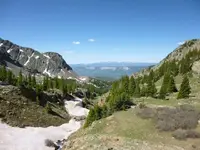Here is a little thought experiment I have been running on this story. Lets assume for a moment that piece of sugar quartz the size of your fist, laden with free gold, WAS indeed found where Twilight Creek and Lime Creek meet. That would be a fairly heavy specimen. Now supposedly Carson found his vein up at the head of Twilight Creek. However, there is a basin up at the head of the creek, and also a small mountain pond in the middle of it. These kinds of ponds/small lakes are very common up in the high country, and usually aren't more than 20 feet deep or so. But where they start draining down the watershed (at least on the surface) there is always an area of ground higher than the bottom of the pond. Otherwise the pond would not form in the first place, and the runoff would never accumulate there.
So then, does that mean the vein must be in a place where any chunks like our fist sized specimen of ore in question would NOT fall into such a pond? If the vein were in the upper basin in a place where ore eroding from it were to fall down into that pond, wouldn't it remain there in that pond until the lip holding the pond back were to erode away?
Of course, it may have taken that fist sized chunk of ore thousands of years to arrive at the bottom of Twilight Creek. But I can't help but wonder how it would get there at all if it were to fall to the bottom of a basin pond. Which MAY mean the vein was located in an area where ore chunks could erode out and fall down the watershed without falling in pond areas.






